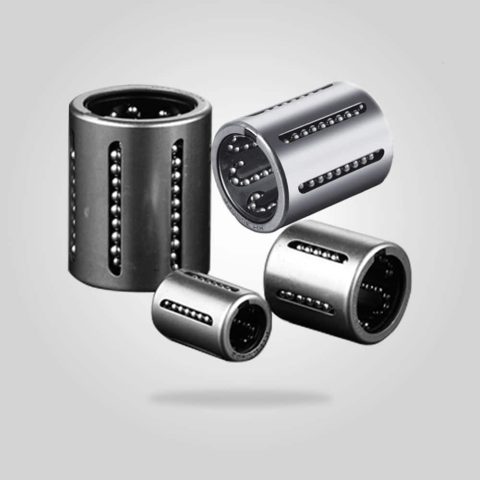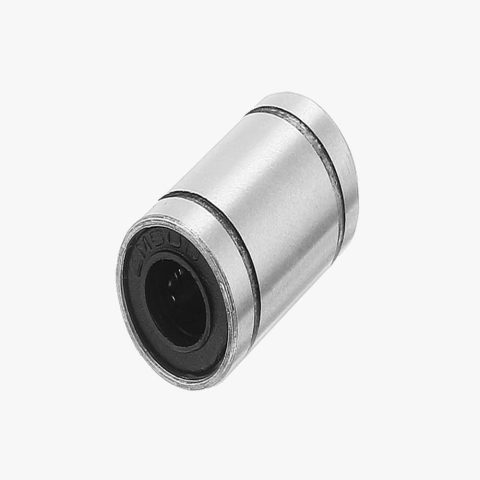Linear bushing LM/LME presents most popular linear bearing in Europe. These types of linear bearings are widely used in different linear motion applications. LM/LME linear bushing has a steel outer ring with grooves for a circlip and a polyamide ball retainer with 3 to 6 ball circuits depending on size. On request linear ball bushing are also available in stainless steel. All linear bearings with the designation UU have seals from both sides.
Linear bushing, LM type is the linear motion system with unlimited stroke by applying with LM shaft. Because of the point contact between balls and LM shaft, minimum friction can be acquired and that can give you the high precision motion. Linear bushing serves the alignment of the balls toward the LM shaft by the single retainer and cylindrical shape of raceway. Outer sleeve is made of bearing steel, and inner and outer grinding processes are applied after heat treatment.
Linear bearings are divided into two series according to the specification: LM and LME series. The linear bearing LM is a standard type. The code LM series is used in Asia, Southeast Asian countries, Japan, Korea, China, etc. In terms of metric size, the tolerance of the outer diameter of the linear shaft is generally h7. The LME series is mostly used in Europe, the United States, Germany, Italy and other regions. In the inch size, there are also metric sizes, and the tolerance of the outer diameter of the linear shaft is generally g6. Two series of structural features, in addition to different sizes, different aperture tolerances, the structure is roughly the same.
check our online catalogProduct Categories
Supplying Linear Bearings Of Virtually Every Type
NPBS Bearings Co., Ltd. keep a range of popular linear ball bearings which includes: LME Series (Metric European) in Open, Adjustable and Closed Design, LM Series (Metric Japanese) and KH Series (Metric Compact). Many of these are available from stock with two wiper seals (-2RS/PP). Linear Ball Bearings are also commonly referred to as Linear Ball Bushings and provide smooth motion of movement along an axis.
- 1LM...UU Series Standard Closed Type Linear Motion Bearings
Linear Ball Bushing Bearings Closed type with Rubber Seals.
- 2LM-AJ Series Adjustable Type Linear Motion Bearings
Linear Ball Bushing Bearings Adjustable type with Rubber Seals
- 3LM-OP Series Open Type Linear Motion Bearings
Linear Ball Bushing Bearings Open type with Rubber Seals
- 4LM...UU Series Double-Wide Closed Type Linear Motion Bearings
Deep Groove Ball Bearings are incredibly versatile and the most widely used. Due to their low friction, they are capable of high rotational speeds, supporting both radial and axial loads. Bearings Direct offers both in metric and inch sizes , also we stock stainless steel made materials metric and inch sizes.
- 5ST Series Ordinary Type Linear Motion Bearings
Electric Motor Quality (EMQ) bearings are designed and and Noise Tested to a noise quality standard. All EMQ Bearings are available in C3 Fit (with limited sizes available in C4 fit). EMQ Bearings offer to include Ceramic Hybrid Balls. Ceramic balls have an even greater density and hardness than a standard ceramic ball.
- 6KH Series Compact Thin Wall Ball Bearing
KH Series Metric Size Self Aligning Closed Linear Ball Bushing Bearing in Shall
QualityPrecision Vs. High Precision
Generally speaking, precision ball bearings comply to ABEC-1 and ABEC-3 tolerances while high-precision ball bearings comply to ABEC-5, ABEC-7, or ABEC-9 tolerances. Some general purpose ball bearings intentionally do not comply to the ABEC precision tolerance specifications and are not graded nor rated as such.
ProfessionalHow to Mount & Dismount Bearing
Successful mounting is critical to the life cycle of your bearing. Proper bearing dismounting can safeguard other machine components and maintenance workers. The rolling bearings mounting and dismounting web application provides step-by-step instructions
PerfectionBearing Failure & How to Prevent
The bearing is at the heart of all rotating equipment, and the condition of the bearing often reflects how well a machine is running. Sometimes, however, bearings fail. In these cases, what’s the first thing you should do? Learn more about bearing damage and bearing failure – and how to prevent it.






